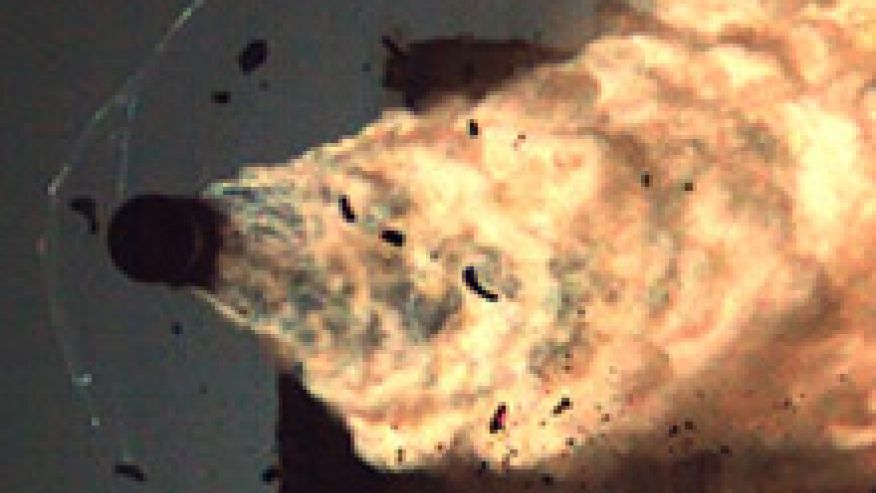
The Navy is evaluating whether to mount its new Electromagnetic Rail Gun weapon aboard the high-tech DDG 1000 destroyer by the mid-2020s, service officials said.
The DDG 1000's Integrated Power System provides a large amount of on board electricity sufficient to accommodate the weapon, Capt. Mike Ziv, Program Manager for Directed Energy and Electric Weapon Systems, told reporters at the Navy League's 2015 Sea Air Space symposium at National Harbor, Md.
The first of three planned DDG 1000 destroyers was christened in April of last year.
Ziv said Navy leaders believe the DDG 1000 is the right ship to house the rail gun but that additional study was necessary to examine the risks. A rigorous study on the issue should be finished by the end of this year, Ziv said.
"I think it's an ideal platform. There is a little bit more work needed to understand the details," he added.
The DDG 1000 is 65-percent larger than existing 9,500-ton Aegis cruisers and destroyers with a displacement of 15,482 tons,.
The DDG 1000's integrated power system, which includes its electric propulsion, helps generate up to 58 megawatts of on-board electrical power, something seen as key to the future when it comes to the possibility of firing a rail gun.
It is also possible that the weapon could someday be configured to fire from DDG 51 Arleigh Burke-class destroyers.
"We've looked at ships as small as DDG 51s. It takes something of that size. This isn't something you are going to put on an LCS," Ziv added.
Meanwhile, the Navy plans to test-fire its new Electromagnetic Rail Gun at sea for the first time in the summer of 2016 from on board the USNS Trenton, a Joint High Speed Vessel, service officials said.
The test shots will take place at Eglin Air Force Base, Fla. During the test, the rail gun will fire a series of GPS-guided hypervelocity projectiles at a barge floating on the ocean about 25 to 50 nautical miles away,
"We're going to fire it against a floating target. We're trying to gauge the ability to engage a target over the horizon," Ziv explained. "We're going to have a gradual ramp up and gather data. This is a significant event but it is also a key learning point."
The Navy is developing the rail gun weapon for a wide range of at-sea and possible land-based applications, Ziv said. The weapon can fire guided, high-speed projectiles more than 100 miles, which makes is suitable for cruise missile defense, ballistic missile defense and various kinds of surface warfare applications.
The railgun uses electrical energy to create a magnetic field and propel a kinetic energy projectile at Mach 7.5 toward a wide range of targets, such as enemy vehicles, or cruise and ballistic missiles.
"The weapon works when electrical power charges up a pulse-forming network. That pulse-forming network is made up of capacitors able to release very large amounts of energy in a very short period of time. The weapon releases a current on the order of 3 to 5 million amps --- that's 1,200 volts released in a ten millisecond timeframe. That is enough to accelerate a mass of approximately 45 pounds from zero to five thousand miles per hour in one one-hundredth of a second," Ziv added.
The hypervelocity projectile is a kinetic energy warhead, meaning it has no explosives engineered into it. This lowers the cost and the logistics burden of the weapon, Ziv said.
The rate of fire is 10-rounds per minute, Ziv said.
Due to its ability to reach speeds of up to 5,600 miles per hour, the hypervelocity projectile is engineered as a kinetic energy warhead, meaning no explosives are necessary. The hyper velocity projectile can travel at speeds up to 2,000 meters per second, a speed which is about three times that of most existing weapons.
Although it has the ability to intercept cruise missiles, the hypervelocity projectile can be stored in large numbers on ships. Unlike other larger missile systems designed for similar missions, the hypervelocity projectile costs only $25,000 per round.
The railgun can draw its power from an onboard electrical system or large battery, Navy officials said. The system consists of five parts, including a launcher, energy storage system, a pulse-forming network, hypervelocity projectile and gun mount.
While the weapon is currently configured to guide the projectile against fixed or static targets using GPS technology, it is possible that in the future the rail gun could be configured to destroy moving targets as well, Ziv explained.
-- Kris Osborn can be reached at kris.osborn@military.com
©2015 FOX News Network, LLC. All rights reserved.
http://www.foxnews.com/tech/2015/04/15/navy-will-test-its-electromagnetic-railgun-aboard-ddg-1000